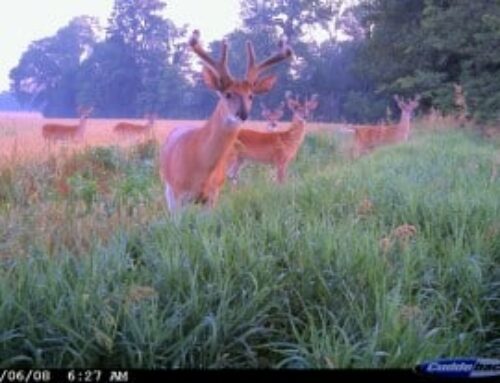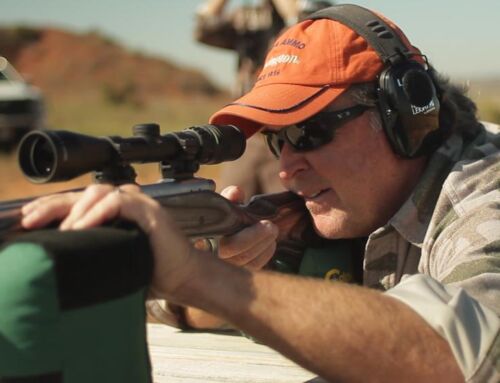 If you’ve got a free day this weekend, go back out to the stands you hunted last fall, walk out from them in an ever-widening circular pattern and look for old sign. You will learn a lot about how deer used the terrain, structure, cover and wind when traveling from bed to feed 3 or 4 months ago. You will find spots where bucks rubbed and scraped the most. You will learn if you need to move your stand 50 to 100 yards…or maybe you’re in a good spot and should stay put…or maybe you should pull out of the area all together. All this will double your chances of whacking a big deer when you come back to hunt in 8 or 9 months.
If you’ve got a free day this weekend, go back out to the stands you hunted last fall, walk out from them in an ever-widening circular pattern and look for old sign. You will learn a lot about how deer used the terrain, structure, cover and wind when traveling from bed to feed 3 or 4 months ago. You will find spots where bucks rubbed and scraped the most. You will learn if you need to move your stand 50 to 100 yards…or maybe you’re in a good spot and should stay put…or maybe you should pull out of the area all together. All this will double your chances of whacking a big deer when you come back to hunt in 8 or 9 months.
Trails
Cut deer trails near your stands and follow them. They will all lead, if in a roundabout way, to food sources and bedding sites. The freshest trails in the snow, mud or leaves come and go to winter food sources. But older, drier, fainter trails are more important. They lead to and from food sources that deer hit back in the fall and during the rut, when most of your hunting took place. If you missed those trails by 100 yards or so when you hung your stands last fall, move them closer before next season.
As you hike the trails, note how they hug brush, cut through low spots, curve around fence corners—all potential funneling spots for stands next season. Also, use a map, compass and your imagination to visualize how the deer on those trails worked into the predominant wind, especially the closer they got to food sources and bedding areas. The more you can nail down how deer use the common winds in your area, the more bucks you will see and shoot.
Rubs
Take note of every “signpost” you run across in the woods. A dominant buck blazed that monster rub last October or November. A cluster of rubs as thick as your calf is really what you want to find. It is sign that the rubber spent a lot of time in a core area close by. He or another mature buck will be back in there rubbing trees this fall.
I’ve noticed that in some parts of the country, notably the Midwest and Southeast, bucks show a preference for rubbing aromatic cedars or pines. Look for trends like that. For example, if you find that 70 percent of last fall’s rubs were on evergreens, you’re on to something. As you scout, veer over to investigate every green patch or strip, especially those near crop fields, oak flats and creeks. You’ll turn up more and more rubs in those spots. You’ll know where a lot of bucks will hang out and blaze new rubs this fall, and you’ll want to hang some stands there.
Look for a rub-location pattern, too. Suppose you find twice as many scarred trees on the tops of ridges than on the sides or in draws. Well, the resident bucks are “ridge toppers,” and it reveals a travel pattern that they’ll use from September through the late season. Work that into your plan and set most of your stands on ridges and hilltops.
Scrapes
In moderate climates and after the snowmelt up North, old scrapes are visible for months. Look for clusters of scrapes, which are hubs of deer traffic and good spots to hang stands this September. Try to find a scrape line and follow it. Put yourself in a buck’s hooves. Scan the woods ahead and visualize how he prowled for does. See how he worked the wind, hugged brush, cut around points, etc. You might find great new spots for stands…or get a better idea of where to watch for bucks coming and going out of your same stands next November.
Sheds
As you hike on the freshest, muddiest trails between winter feeding and bedding sites, look for just-cast antlers. Find a big chunk of 4- or 5-point bone (and both sides if you’re lucky) and you know one thing—a shooter that you saw last season (or maybe you didn’t see him) survived the hunting season, and if doesn’t get hit by a car over the summer, there’s a good chance he’ll be on your land next season.
It gives you something to think about as you analyze all the old sign you just found and work it into a fresh hunting plan for the fall of 2018.






MIke, Bucks here will pick Cedars, Basswoods, PInes (where available), Quaking Aspen (where available), Cherry, as well as others to do their rubbing. Practically all of these species are of the aromatic variety. Bucks especially love to rub Red Cedar around here. You always know which ones are doing the rubbing on those Junipers/Conifers because they’er always darker around the bases, etc. Buck rubs like the signpost in the picture above are my favorites to look at and to study, etc. I found my first shed antler (while actually looking for sheds) underneath a big, rubbed Red Cedar tree. It was a very comfortable bed for that buck.I estimated that particular buck to be 3.5 years old. The next summer that guy blew up into a beastly, 150-class bruiser. Although I never killed that buck, he was one that I wanted very badly…..which kinda goes without saying I suppose.
Funny you posted this today just this past weekend 2 buddies and I spent President’s weekend up at my place in the mountains doing just this. We followed trails out of food plots into the thickest nastiest stuff on my property an found more rubs than I thought existed on the place some were indeed from last fall but there were some that I aged as 2-4 years old too. Funny thing I have no stands near that trail but have often thought about “checking it out” I know this summer when it is 85 and humid I will be hanging a couple stands closer to there.
We also saw a couple rack bucks with both sides non shed as of yet that seems odd to me.